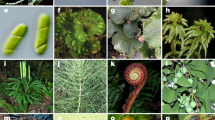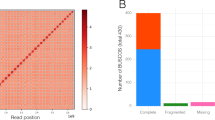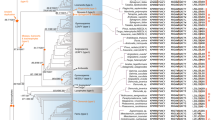Abstract
THE Kranz syndrome is a group of related anatomical, cytological and physiological characters reported one way or another in about 10 families of angiospermous plants. The syndrome centres around the CO2 fixation aspect of photosynthesis, including synthesis of C4-dicarboxylic acids as the initial products of CO2 assimilation, utilization of most of the available CO2 producing a high 13C/12C ratio, having maximum efficiency at high temperatures, and all related to a sheath around the bundles in the leaf. All present evidence indicates that detection of any one of the aspects of the syndrome denotes the whole syndrome1. The syndrome is uncommon among plants including angiosperms and is therefore considered to be the evolved or derived condition. Although in Atriplex2 it seems to have evolved recently within the genus, in the Gramineae the evolution of the Kranz syndrome seems to have occurred only two or three times early in grass evolution. This assumption, which is fundamental in this discussion, is based on the uniformity of tribes and subfamilies as Kranz or non-Kranz, and the proven predictability of the syndrome from single aspects of it (in this work from the 13C/12C ratio), from various other characters, or from classification3. The only exception reported, of Kranz and non-Kranz species within one grass genus, is within Panicum4 where the subgenus Dichanthelium is non-Kranz whereas the more typical species of the subgenus Eupanicum are characterized by the Kranz syndrome (Table 1). Recently we found, by determination of 13C/12C ratios of over 180 species, in 110 genera, of forty tribes of grasses, evidence of both types also among species of Eupanicum as well as among genera of the tribe Paniceae and among tribes of the subfamily Panicoideae (Table 1). It is this diversity of panicoid tribes (many of which are small and endemic), of the tribe Paniceae, and the genus Panicum that provides clues to the likely evolution of the grass family, superimposed, of course, on a great deal of other morphological, anatomical, cytological, and physiological evidence3,5. Furthermore, now that geology has accepted Wegenerian drifting continents and the break-up of an ancient single world-continent (Pangaea) by rifting under the concept of plate tectonics, evolution of the Gramineae can be discussed in terms of that concept; that is, Upper Jurassic–Middle Cretaceous separation of East Gondwana and the Middle to Late Cretaceous separation of South America from Africa, with the tropical belt approximately in its present relationship to the continents since Early Jurassic time6.
This is a preview of subscription content, access via your institution
Access options
Subscribe to this journal
Receive 51 print issues and online access
$199.00 per year
only $3.90 per issue
Buy this article
- Purchase on Springer Link
- Instant access to full article PDF
Prices may be subject to local taxes which are calculated during checkout
Similar content being viewed by others
References
Smith, B. N., and Epstein, S., Plant Physiol., 47, 380 (1971); Tregunna, E. B., Smith, B. N., Berry, J. A., and Downton, W. J. S., Canad. J. Bot., 48, 1209 (1970).
Björkman, O., Nobs, M. A., Pearcy, R. W., and Berry, J. A., Carnegie Inst. Wash. Year Book, 68, 620; ibid., 69, 622 (1970, 1971).
Tateoka, T. J., Jap. Bot., 32, 275 (1957); Brown, W. V., Bot. Gaz., 119, 170 (1958); Prat, H., Bull. Soc. Bot. France, 107, 32 (1960); Stebbins, G. L., and Crampton, B., Recent Advances Bot., 133 (University of Toronto Press, 1961); Augier, P., Natura Mosana, 16, 1 (1963).
Downton, J., Berry, J., and Tregunna, E. B., Science, 163, 78 (1969); Krenzer, E. G., and Moss, D. N., Crop Sci., 9, 619 (1969).
Tateoka, T., Taxon, 18, 263 (1969).
Wegener, A., The Origin of Continents and Oceans. Biram translation of fourth ed. of 1929 (Dover, New York, 1966); Fooden, J., Science, 175, 895 (1972); Fox, P. J., and Heezen, G. L., Science, 170 (1970); Raven, P. H., and Axelrod, D. L., Science, 176, 1379 (1972).
Brown, W. V., Textbook of Cytogenetics (Mosby, St Louis, 1972); Walker, J. W., Taxon, 21, 57 (1972).
Hartley, W., Austral. J. Bot., 6, 343 (1958).
Hartley, W., Austral. J. Bot., 6, 116 (1958).
Hartley, W., and Slater, C., Austral. J. Bot., 8, 256 (1960).
Brown, W. V., Southwest. Nat., 5, 7 (1960).
Brown, W. V., Bot. Gazette, 119, 170 (1958); Brown, W. V., Recent Advances in Botany, 105 (1961).
Johnson, sen., C., dissertation, Univ. Texas, Austin (1964).
Author information
Authors and Affiliations
Rights and permissions
About this article
Cite this article
BROWN, W., SMITH, B. Grass Evolution, the Kranz Syndrome, 13C/12C Ratios, and Continental Drift. Nature 239, 345–346 (1972). https://doi.org/10.1038/239345a0
Received:
Issue Date:
DOI: https://doi.org/10.1038/239345a0
This article is cited by
-
Molecular comparison of carbonic anhydrase from Flaveria species demonstrating different photosynthetic pathways
Plant Molecular Biology (1995)
-
Distribution and evolution of C4 syndrome inRhynchospora (Rhynchosporeae-Cyperaceae)
The Botanical Magazine Tokyo (1987)
-
The distribution of C3 and C4 grasses and carbon isotope discrimination along an altitudinal and moisture gradient in Kenya
Oecologia (1979)
-
A C4 plant from the Pliocene
Nature (1978)
-
?13C values of grass species collected in the northern Sahara desert
Oecologia (1976)
Comments
By submitting a comment you agree to abide by our Terms and Community Guidelines. If you find something abusive or that does not comply with our terms or guidelines please flag it as inappropriate.



